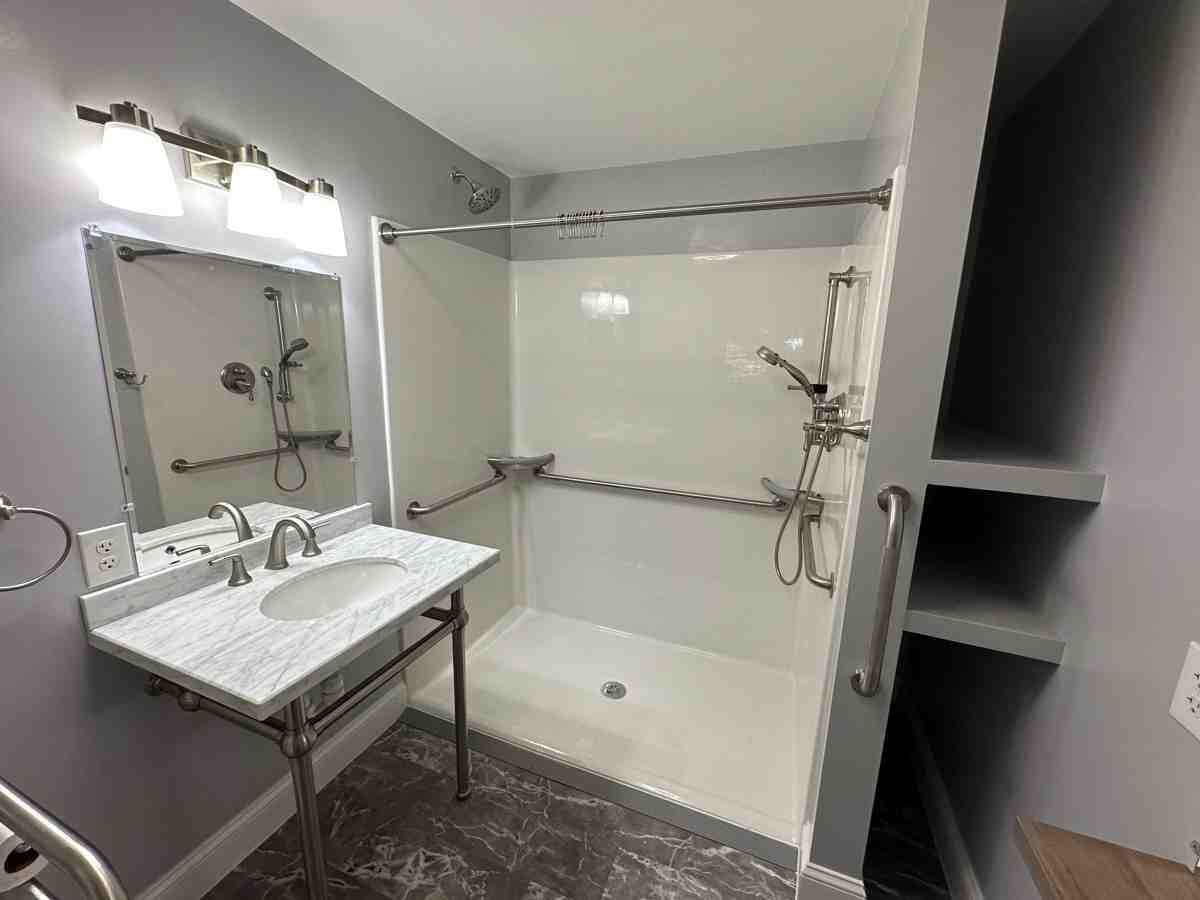Handicap Bathroom Contractors Near Me: Top 5 Expert Picks 2024
If you’re looking for handicap bathroom contractors near me, finding the right contractor is essential for ensuring a safe and comfortable bathroom. Handicap accessible bathrooms are crucial for individuals with mobility challenges and the elderly, as they provide independence and safety while adhering to ADA (Americans with Disabilities Act) guidelines.
Quick Tips to Get You Started:
- Ensure ADA Compliance: Verify that the contractor is knowledgeable about ADA standards and ensures all modifications are compliant.
- Look for Local Expertise: Contractors familiar with Middlesex County, MA regulations can offer custom solutions.
- Check Past Projects: Review their portfolio to understand their craftsmanship and attention to detail.
- Read Customer Reviews: Ensure the contractor has a strong reputation for punctuality and quality.
- Discuss Financing Options: Get a clear understanding of costs, budgets, and available financing.
Handicap accessible bathrooms should feature wide doorways for wheelchair access, grab bars for stability, and roll-in showers or walk-in tubs for ease of use. These elements create a functional space that meets safety standards, allowing residents to live more comfortably.
I’m Tyler Tranni, owner of Tranni Home Remodeling. With years of experience specializing in handicap bathroom contractors near me, I understand the intricacies of creating safe, accessible, and beautiful spaces. Trust us to transform your bathroom into a haven of independence and comfort.

Basic handicap bathroom contractors near me terms:
– bath and kitchen remodeling contractor
– kitchen and bath remodeling contractors
Understanding ADA Requirements for Handicap Bathrooms
Key ADA Bathroom Features
Designing a handicap-accessible bathroom involves adhering to specific ADA guidelines. These guidelines ensure that the bathroom is safe and accessible for individuals with mobility challenges.
ADA Standards
The ADA (Americans with Disabilities Act) sets the standards for accessible bathroom designs. These standards cover everything from door width to fixture placement, ensuring maximum accessibility.
Bathroom Dimensions
According to the ADA, a single-user handicapped bathroom should include:
– A clear turning space of 60” or more to allow for turning around the sink.
– A space of 30” x 48” access to the sink.
– At least 16” centerline of the toilet from the wall.
– At least 36” entrance space.
These dimensions help ensure that the bathroom is spacious enough for wheelchair users to maneuver comfortably.
Accessible Fixtures
Accessible fixtures are essential for a handicap bathroom. This includes sinks, toilets, and showers designed for ease of use. For instance, sinks should have a space of 30” x 48” for wheelchair access, and toilets should be at least 16” from the wall to provide enough space.
Door Width
The entrance to a handicap bathroom should be at least 36 inches wide to accommodate a wheelchair. Avoid steps at the entrance; instead, use a low-profile ramp to allow for easy roll-over.
Grab Bars
Grab bars are crucial for stability and safety in a handicap bathroom. They should be installed near the toilet, in the shower, and near the bathtub. According to ADA guidelines, grab bars should be positioned at an easy-to-reach range and be capable of supporting significant weight.
Roll-In Showers
A roll-in shower is an excellent investment for a handicap bathroom. These showers are curbless, eliminating barriers and allowing seamless maneuvering for wheelchair users. According to ADA guidelines, a roll-in shower should have:
– A built-in wall-mounted shower seat.
– A grab bar positioned on the back wall.
– A showerhead attached to a 60-inch hose.
– A curb height of no more than ½ inch from the base.
Non-Slip Flooring
Safety is paramount in a handicap bathroom. Non-slip flooring prevents accidents and provides a secure surface for walking or rolling. Choose materials that offer good traction even when wet.
Accessible Sinks
Sinks in a handicap bathroom should be accessible to all users. This means having enough clearance underneath for a wheelchair and ensuring the faucet is easy to reach and operate. The ADA recommends a space of 30” x 48” for wheelchair access to the sink.
If you’re considering a bathroom remodel to make it handicap accessible, these key ADA features are essential. Ensuring your bathroom meets these standards will provide safety and independence for all users.
Next, we’ll dive into how to convert your current bathroom into a handicap-accessible space.
How to Convert Your Bathroom to Handicap Accessible
Essential Modifications
Changing your bathroom to be handicap accessible involves several key modifications. These changes ensure safety, comfort, and independence for individuals with mobility challenges.
Roll-In Showers
A roll-in shower is a must-have for a handicap-accessible bathroom. These showers are curbless, allowing for easy access with a wheelchair or walker. According to ADA guidelines, they should feature:
- A built-in, wall-mounted shower seat.
- A grab bar on the back wall for stability.
- A showerhead attached to a 60-inch hose.
- A curb height of no more than ½ inch from the base.
Accessible Baths
For those who prefer baths, a walk-in tub is an excellent investment. Walk-in tubs have doors that open, allowing users to step in without having to climb over the edge. This feature significantly reduces the risk of falls.
Stability Hardware
Stability hardware, such as grab bars, is crucial for safety. Install grab bars near the toilet, in the shower, and next to the bathtub. According to ADA guidelines, these bars should be positioned within easy reach and be capable of supporting significant weight to ensure maximum safety.
Door Widening
Widening doorways is essential to accommodate wheelchairs. The ADA recommends a minimum door width of 36 inches. Avoid steps at the entrance and consider installing a low-profile ramp for smooth access.
Sink and Toilet Height Adjustment
Adjusting the height of sinks and toilets makes them more accessible. Sinks should have a clearance of 30” x 48” underneath for wheelchair access, and toilets should be at least 16 inches from the wall to provide enough space for maneuvering.
Grab Bars
Grab bars provide essential support and stability. They should be installed at strategic locations, such as next to the toilet, in the shower, and near the bathtub. Make sure they are securely mounted and can support significant weight.
Walk-In Tubs
Walk-in tubs are designed with a door that opens, allowing easy entry without the need to step over a high edge. These tubs are ideal for individuals with limited mobility and reduce the risk of slipping and falling.
Non-Slip Flooring
Non-slip flooring is vital in a handicap-accessible bathroom. Choose materials that offer good traction even when wet to prevent accidents. This simple change can make a significant difference in safety.
Ramps
If there are any steps leading to the bathroom, consider installing ramps. Ramps provide easy access for wheelchairs and walkers, ensuring that everyone can enter and exit the bathroom safely.
These essential modifications are crucial for making your bathroom handicap accessible. By incorporating these changes, you can create a safe, comfortable, and independent environment for all users.
Next, we’ll explore tips for choosing the best handicap bathroom contractors near you.
Top 5 Tips for Choosing Handicap Bathroom Contractors Near Me
Finding the right contractor for your handicap bathroom remodel can be challenging. To make the process easier, here are five key tips to consider:
Evaluating Contractor Experience
Certifications Matter
When evaluating contractors, prioritize those with relevant certifications. Look for certifications such as CAPS (Certified Aging in Place Specialist), which ensures that the contractor has specialized knowledge in designing accessible spaces.
Past Projects Speak Volumes
Ask potential contractors to showcase their past projects. Seeing their previous work can give you a sense of their capabilities and attention to detail. For instance, a contractor who has successfully completed multiple ADA-compliant bathrooms will likely understand the nuances of accessibility design.
Customer Testimonials
Reading customer reviews and testimonials can provide valuable insights into a contractor’s reliability and quality of work. Websites like Houzz and the Better Business Bureau (BBB) are great places to find reviews. Look for comments on timeliness, professionalism, and the overall satisfaction of past clients.
Importance of Local Expertise
Middlesex County, MA Regulations
Hiring a contractor familiar with local regulations in Middlesex County, MA, is crucial. Local expertise ensures that your remodel complies with all local building codes and ADA requirements. This can save you time and money by avoiding potential legal issues.
Community Reputation
A contractor with a strong reputation in the community is likely a safer bet. Ask around or check local forums and social media groups for recommendations. A contractor well-regarded in the community will be motivated to maintain their good standing by delivering high-quality work.
Customer Reviews
Check Multiple Platforms
Don’t rely on just one source for reviews. Check multiple platforms like Google, Yelp, and Angie’s List to get a comprehensive view of a contractor’s reputation. Consistently positive reviews across various sites are a good indicator of reliable service.
Look for Specific Feedback
Pay attention to reviews that mention specific aspects of the project, such as adherence to timelines, quality of materials used, and the contractor’s communication skills. This detailed feedback can help you gauge whether the contractor will meet your specific needs.
Certifications
CAPS Certification
As mentioned earlier, CAPS certification is a significant credential. It indicates that the contractor has undergone specialized training to understand the needs of aging and disabled individuals. This certification can be a deciding factor when choosing between contractors.
BBB Accreditation
BBB accreditation is another important certification to consider. It means the contractor adheres to high standards of trust and ethical business practices. Contractors with BBB accreditation are often more reliable and professional.
Project Portfolio
Diverse Experience
A diverse project portfolio showcases a contractor’s versatility and experience. Look for contractors who have completed a variety of projects, especially those similar to your own. This demonstrates their ability to handle different challenges and deliver quality results.
Before and After Photos
Request before and after photos of previous projects. These images can give you a clear idea of the contractor’s skills and the changes they can achieve. It’s also a great way to get inspiration for your own remodel.
Financing Options
Flexible Payment Plans
Remodeling can be expensive, so it’s important to consider contractors who offer flexible payment plans. Some contractors may provide financing options that allow you to spread the cost over time, making the project more manageable financially.
Insurance Claims
If your remodel is related to an insurance claim, choose a contractor experienced in handling such projects. They can assist with the necessary paperwork and ensure that all work meets insurance requirements.
By following these tips, you can find the best handicap bathroom contractors near me to ensure a successful and stress-free remodeling project.
Next, we’ll dive into the cost considerations for handicap bathroom remodeling.
Cost Considerations for Handicap Bathroom Remodeling
Breakdown of Common Costs
When planning a handicap bathroom remodel, understanding the costs involved is crucial. Here’s a breakdown of common expenses and tips for budget planning and financing options.
Average Costs
A handicap bathroom remodel can vary widely in cost based on the extent of modifications and the quality of materials used. A simple makeover might cost a few thousand dollars, while a comprehensive remodel could range from $15,000 to $30,000 or more.
Factors like the size of the bathroom, the complexity of the modifications, and the choice of fixtures all play a role in determining the final cost.
Budget Planning
To avoid unexpected expenses, plan your budget carefully. Start by listing all the modifications you need, such as installing grab bars, a roll-in shower, or a walk-in bathtub. Then, get quotes from multiple contractors to compare prices and services.
Consider prioritizing essential modifications first and add luxury features if your budget allows. Keeping some flexibility in your budget can also help manage any unforeseen costs that may arise during the remodel.
Financing Options
Remodeling can be a significant investment, so exploring financing options can be helpful. Some contractors offer flexible payment plans that allow you to spread the cost over time. Additionally, look into home improvement loans or lines of credit that can provide the necessary funds for your project.
If your remodel is related to an insurance claim, ensure your contractor is experienced in handling such projects. They can assist with the necessary paperwork and ensure that all work meets insurance requirements.
Walk-In Shower
Installing a walk-in shower is a popular choice for handicap bathrooms. It provides easy access and improves safety for individuals with mobility issues. The cost of a walk-in shower can range from $2,500 to $15,000, depending on the materials and design.
For a roll-in shower, which is wheelchair accessible, ensure there is enough space for maneuvering and consider adding a built-in wall-mounted shower seat for convenience.
Bathtub Conversion
Converting a standard bathtub into a walk-in tub can be a game-changer for those with disabilities. Walk-in tubs typically feature a door for easy entry and exit, reducing the risk of slips and falls. The cost for a walk-in tub can range from $2,000 to $10,000 or more.
Toilet Installation
Installing an ADA-compliant toilet is another key modification. These toilets are higher than standard models, making it easier for individuals with mobility issues to sit and stand. The cost of an ADA-compliant toilet ranges from $300 to $800, plus installation fees.
Sink Adjustments
Adjusting the height of the sink or installing a wall-mounted sink can improve accessibility. Ensure there is enough clearance underneath for wheelchair users. The cost for sink adjustments can vary from $200 to $1,000, depending on the complexity of the modifications.
By understanding these cost considerations and planning your budget accordingly, you can ensure a smooth and successful handicap bathroom remodel.
Next, let’s address some frequently asked questions about handicap bathroom remodeling.
Frequently Asked Questions about Handicap Bathroom Remodeling
What are the federal requirements for a handicapped bathroom?
Federal requirements for handicapped bathrooms are set by the Americans with Disabilities Act (ADA). These standards ensure that bathrooms are accessible and safe for individuals with disabilities. Here are some key ADA requirements:
- Bathroom Dimensions: A single-user handicapped bathroom must have a clear turning space of at least 60 inches in diameter to allow for wheelchair maneuvering.
- Accessible Fixtures: Sinks should have a clear floor space of 30 inches by 48 inches for wheelchair access. The sink should be mounted with the front edge no higher than 34 inches from the floor.
- Door Width: Doors must be at least 36 inches wide to accommodate wheelchairs and should have lever handles for ease of use.
- Toilet Clearance: The centerline of the toilet should be 16 to 18 inches from the adjacent wall, with grab bars installed for support.
How do I convert my bathroom to handicap accessible?
Converting a bathroom to be handicap accessible involves several key modifications. Here are some essential steps:
- Roll-In Shower: Replace the bathtub with a roll-in shower that has no curb, allowing easy access for wheelchairs. Make sure the shower is spacious enough to accommodate a shower seat or a wheelchair.
- Accessible Bath: Consider installing a walk-in bathtub with a door for easy entry and exit.
- Stability Hardware: Install grab bars near the toilet, shower, and bathtub to provide support and prevent falls.
- Door Widening: Ensure the bathroom door is at least 36 inches wide to accommodate wheelchair access.
- Sink and Toilet Height Adjustment: Adjust the height of sinks and toilets to meet ADA standards. Wall-mounted sinks provide more space underneath for wheelchair users.
What does a handicap accessible bathroom look like?
A handicap accessible bathroom is designed with safety and ease of use in mind. Here are some features you might find:
- Door Width and Turning Space: The door is at least 36 inches wide, and there is a clear turning space of 60 inches in diameter.
- Accessible Fixtures: Sinks are mounted at a height no higher than 34 inches, with clear space underneath for wheelchair access. Toilets are positioned with enough clearance and equipped with grab bars.
- Roll-In Shower: The shower area is curbless and spacious, with grab bars and a built-in wall-mounted shower seat.
- Non-Slip Flooring: The bathroom floor is covered with non-slip materials to prevent accidents.
- Ramps: If necessary, ramps are installed to eliminate any steps leading into the bathroom.
By following these guidelines and incorporating these features, you can create a bathroom that is both functional and safe for individuals with disabilities.
Next, let’s dive into more detailed cost considerations for your handicap bathroom remodel.
Conclusion
At Tranni Home Remodeling, we pride ourselves on delivering high-quality craftsmanship and outstanding service for all our clients. When it comes to handicap bathroom remodeling, our expertise ensures that your bathroom is not only ADA-compliant but also safe and accessible for everyone.
Why Choose Tranni Home Remodeling?
- High-Quality Craftsmanship: Our team is skilled in creating beautiful, functional spaces. We use top-notch materials and pay attention to every detail to ensure your bathroom meets the highest standards.
- Outstanding Service: From the initial consultation to the final walk-through, we are committed to providing excellent customer service. We listen to your needs and work closely with you throughout the entire process.
- Local Expertise: Serving Middlesex County, MA, we understand the local regulations and community expectations. Our knowledge of the area allows us to provide custom solutions that fit your specific needs.
Our Commitment to You
We know that remodeling a bathroom to be handicap accessible can feel overwhelming. That’s why we’re here to guide you every step of the way. Whether it’s installing a roll-in shower, adjusting the height of sinks and toilets, or ensuring there are enough grab bars for stability, we make sure every aspect of your bathroom is accessible and safe.
Ready to Get Started?
If you’re looking for handicap bathroom contractors near me, look no further than Tranni Home Remodeling. Our team is ready to transform your bathroom into a space that is both functional and beautiful.



